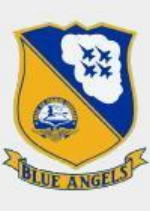Hobby Master HA1109 US Navy Grumman F6F-5 Hellcat Fighter - Roy "Butch" Voris, "The Blue Angels" First Plane (1:72 Scale)
" [The US] Navy Flight Exhibition Team thrilled spectators with low-flying maneuvers performed in tight formations, and (according to Voris) by "...keeping something in front of the crowds at all times. My objective was to beat the Army Air Corps. If we did that, we'd get all the other side issues. I felt that if we weren't the best, it would be my naval career."
- Lieutenant Commander Roy Marlin "Butch" Voris, a World War II fighter ace, named Officer-in-Charge and Flight Leader of the US Navy's first flight demonstration squadron
 The F6F embodied the early lessons learned by users of Grumman's previous fleet-defense fighter, the Wildcat. In June 1941, Grumman lowered the wing center section to enable the undercarriage to be wider splayed, fitting more armor-plating around the cockpit to protect the pilot while also increasing the fighter's ammunition capacity. When the prototype made its first flight, it was realized that a more powerful engine was needed to give the fighter a combat edge. A Pratt & Whitney R-2800-10 engine was installed for added power.
The F6F embodied the early lessons learned by users of Grumman's previous fleet-defense fighter, the Wildcat. In June 1941, Grumman lowered the wing center section to enable the undercarriage to be wider splayed, fitting more armor-plating around the cockpit to protect the pilot while also increasing the fighter's ammunition capacity. When the prototype made its first flight, it was realized that a more powerful engine was needed to give the fighter a combat edge. A Pratt & Whitney R-2800-10 engine was installed for added power.
The aircraft made its combat debut in August 1943, and from that point on, the question of aerial supremacy in the Pacific was never in doubt. Hellcats served aboard most of the US Navy's fleet carriers, being credited with the destruction of 4,947 aircraft up to V-J Day. The Fleet Air Arm was also a great believer in the Hellcat, procuring almost 1,200 planes between 1943-45. The Hellcat saw only limited service in the post-war years, being replaced by the more powerful F9F Bearcat. Of the nine F6Fs believed to be airworthy today, seven are based in the USA and two are located in the UK.
This particular 1:72 scale replica of a F6F-5 Hellcat was the first plane flown by US Navy's Blue Angels Aerobatic Squadron.
Sold Out!
Dimensions:
Wingspan: 5-inches
Length: 5-inches
Release Date: June 2008
 Historical Account: "Precision Flying" - The United States Navy's Flight Demonstration Squadron, popularly known as the Blue Angels, was formed in 1946 and is the world's first officially sanctioned military aerial demonstration team.
Historical Account: "Precision Flying" - The United States Navy's Flight Demonstration Squadron, popularly known as the Blue Angels, was formed in 1946 and is the world's first officially sanctioned military aerial demonstration team.
The Blue Angels first flew three aircraft in formation, then four, and currently operate six aircraft per show. A seventh aircraft is for backup, in the event of mechanical problems with one of the other aircraft, and for giving public relations "demonstration flights" to civilians, usually selected from a press pool.
This aerobatic team is split into "the Diamond" (Blue Angels 1 through 4) and the Opposing Solos (Blue Angels 5 and 6). Most of their displays alternate between maneuvers performed by the Diamond and those performed by the Solos.
The Diamond, in tight formation and usually at lower speeds, performs maneuvers such as formation loops, barrel rolls, or transitions from one formation to another.
The Opposing Solos usually perform maneuvers just under the speed of sound which showcase the capabilities of their individual F/A-18 Hornets through the execution of high-speed passes, slow passes, fast rolls, slow rolls, and very tight turns. Some of the maneuvers include both solo F/A-18s performing at once, such as opposing passes (toward each other in what appears to be a collision course, narrowly missing one another) and mirror formations (back-to-back. belly-to-belly, or wingtip-to-wingtip, with one jet flying inverted).
At the end of the routine, all six aircraft join in the Delta formation. After a series of flat passes, turns, loops, and rolls performed in this formation, they execute the team's signature "fleur-de-lis" closing maneuver.
The parameters of each show must be tailored to local visibility: In clear weather the "high" show is performed, in overcast conditions it's the "low" show that the spectators see, and in limited visibility (weather permitting) the "flat" show is presented. The "high" show requires an 8,000-foot (2,400 m) ceiling and visibility of 3 nautical miles (6 km) from the show's centerpoint. "Low" and "flat" ceilings are 3,500 and 1,500 feet (460 m) respectively. (courtesy: Wikipedia)


